|
|
|
 |
| Discover
Ancient Egypt |
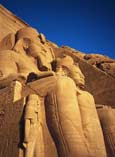  Names
like Ramses,
Cleopatra,
Tutankhamun and
Nefertiti, echo
through the art
and literature
of so many
different
cultures.
Religion was the
backbone of life
in Ancient Egypt
and mythology
its bloodline.
Death and the
afterlife were
essential to
Ancient Egyptian
society. Names
like Ramses,
Cleopatra,
Tutankhamun and
Nefertiti, echo
through the art
and literature
of so many
different
cultures.
Religion was the
backbone of life
in Ancient Egypt
and mythology
its bloodline.
Death and the
afterlife were
essential to
Ancient Egyptian
society.
5,000 years ago,
the first
Pharaoh, King
Narmer, founded
the world's
first nation
state, recording
it in the
world's first
written script.
The pharaohs
were not just
kings or queens,
they were gods
and they were
worshipped as
divine rulers.
But they also
commanded vast
administrative
armies, models
of modern
management and
efficiency.
It was their
sophisticated
system of
bureaucracy that
enabled the
construction of
Egypt's greatest
monuments, the
pyramids of
course and also
the tombs in the
Valley of the
Kings, the great
temples of
Karnak, the
ruins of Thebes
not forgetting
the Sphinx at
Giza.
The relics of
Ancient Egypt
still survive to
bear witness to
the refinement
and beauty of
many golden
ages.
THE PYRAMIDS
Although the
construction of
the pyramids was
only an episode
in the long
history of the
pharaohs, this
period has left
us some of the
most impressive
monuments that
can be seen.
Besides the
three giants of
Gizeh, more than
70 pyramids can
be counted along
the Nile.
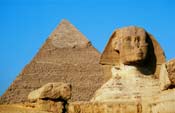 Al
Giza Pyramids Al
Giza Pyramids
Guarded by the
familiar lone
lion-bodied
Sphinx are the
three Great
Pyramids of Giza.
Over 4,000 years
ago, the
mummified bodies
of Kings Cheops,
Kefren and
Mykerinos were
ferried down the
Nile to be
buried and
prepared for the
journey to the
afterlife within
these massive
monuments.
The largest,
oldest and
finest of all
three is Cheop's
Pyramid, simply
known as the
"Great Pyramid".
It was the
tallest
structure in the
world until the
end of the
nineteenth
century (145
meters). But
Kefren's
Pyramid, Cheop's
son and
successor, makes
a bigger first
impression. On
higher ground
with its
limestone cap
still intact, it
looks loftier
even though it's
4 meters
shorter.
The smallest of
the three,
Mykerinos'
Pyramid, makes
up for its size
with its fine
funerary and
valley temples.
But the Giza
necropolis is
also the final
resting place of
the Pharaoh's
family and high
officials.
Buried inside
the mastabas and
minor pyramids
which dot the
plateau are
queens and royal
courtiers. There
are also tombs
of the craftsmen
and engineers
who toiled over
these epic
edifices.
 Dahshur
Pyramids Dahshur
Pyramids
There were
originally 11
pyramids at
Dahshur,
although only
the two Old
Kingdom
Pyramids, the
Bent and the Red
Pyramid, remain
intact. Pharaoh
Sneferu, father
of Khufu and
founder of the
4th Dynasty,
built Egypt's
first real
pyramid, the Red
Pyramid, here.
It is a quiet
place where you
will be able to
enjoy the
monuments in
peace.
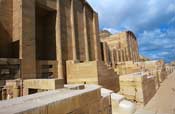 Saqqara
Pyramids Saqqara
Pyramids
Time has all but
erased the once
mighty Memphis
from the
Egyptian
landscape,
however, the
city of the dead
has been
excavated and
exhumed from the
desert sands,
the vast
necropolis of
Saqqara. Memphis
is some 23km
south of central
Cairo, in the
center of the
floodplain on
the western side
of the Nile.
Memphis was
traditionally
founded in 3000
BC by Menes, the
legendary figure
credited with
the creation of
a politically
unified Egypt.
Memphis served
as the effective
administrative
capital of the
country during
the Old Kingdom
and partly in
later times.
It's eleven
pyramids,
countless
mastabas and
lone Coptic
monastery
stretch over 7km
from north to
south, and span
three and a half
thousand years
of Egyptian
civilisation. At
its centre sits
King Djoser's
"Stepped"
Pyramid, the
very first
pyramid and the
first great
stone structure
in the world.
North of the
pyramid, inside
a stone "serdab",
sits the Ancient
Pharaoh himself.
Saqqara also
includes the
Serapeum,
represented by a
life-sized
sculpture of
limestone, the
original of
which is in the
Egyptian Museum
in Cairo, and an
astonishing
collection of
mummified Apis
bulls in
gargantuan
granite coffins.
Of its eleven
pyramids, King
Teti boasts the
best preserved
burial chamber,
with pyramid
text lined walls
mapping out his
journey to the
afterlife. The
walls of
Mereruka's
multichambered
maze-like tomb
are covered with
exquisite
murals, showing
scenes of
everyday life.
TEMPLES
Life in Ancient
Egypt revolved
around religion.
The pharaohs
traced their
ancestry back to
the gods of the
Egyptian
pantheon.
Different
pharaohs allied
themselves to
different cults,
and the
elaborate
temples they
built cemented
their own
political
status. With
intricately
painted walls,
vast colonnaded
courts and
columned
hypostyle halls,
the temples of
Ancient Egypt
are among its
greatest
cultural
triumphs.
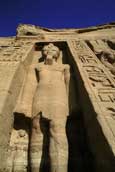 The
Temples of Abu
Simbel (Nubia) The
Temples of Abu
Simbel (Nubia)
Of all the
pharaohs, Ramses
II was the most
prolific builder
of monuments and
temples. Two of
his greatest
temples, the
Great Temple of
Abu Simbel and
its smaller
cousin, the
Temple of Hathor
are at Abu
Simbel. Both
temples
originally sat
some sixty
metres below
where you find
them today. They
were part of a
massive UNESCO
operation to
save Egypt's
Great Temples
from Lake
Nasser's rising
waters. Embedded
into the
mountain itself,
the temples had
to be cut free
from the rock
and
painstakingly
dismantled and
rebuilt.
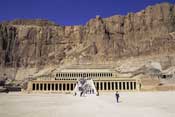 The
Temple of Queen
Hatshepsut
(Thebes) The
Temple of Queen
Hatshepsut
(Thebes)
At the base of a
lofty limestone
mountain in the
desert at Thebes
nestles Queen
Hatshepsut's
astonishing
terraced temple.
Hatshepsut was
Egypt's greatest
female Pharaoh.
She fought off
male pretenders
to her throne
for over 20
prosperous and
peaceful years.
Partly embedded
into the
mountain itself,
the temple is
almost forty
metres wide. Its
honeycomb
colonnades pick
up the natural
lines and
recesses of its
mountainous
backdrop.
Hatshepsut's
temple is
essentially an
extension of
Mentuhotep II's
temple, though
several times
its size. The
two blend in so
well together,
they are
indistinguishable
from a distance.
 The
Temple of Luxor The
Temple of Luxor
Though Ramses
II's triumphant
twin statues
stand sentry at
its entrance, it
was Amenhotep
III who built
the bewildering
Temple of Luxor.
Over the years,
several of
Egypt's
legendary rulers
added to the
glory of the
Temple of Luxor,
from Tutankhamun
to Alexander the
Great.
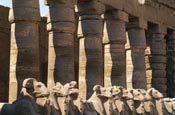 The
Temple of Karnak The
Temple of Karnak
The most
important place
of worship in
all Egypt during
Theban power. It
was built,
dismantled,
restored,
enlarged and
decorated by
several
pharaohs. It's a
complex of
sanctuaries,
obelisks and
pylons,
dedicated to the
glory of the
pharaohs. It's a
gigantic site :
1.5km by 800m.
Impossible to
describe, this
immense monument
has to be seen,
to be believed.
From the
entrance to the
Amun Temple
Enclosure you
pass down the
processional
avenue of
ram-headed
sphinxes that
originally
flanked a canal
connecting the
temple to the
Nile.
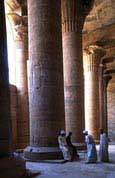 The
Temple of Horus
(Edfu) The
Temple of Horus
(Edfu)
A very well
preserved
Egyptian temple,
much newer than
other temples.
Its state of
preservation
helps to fill
some historical
gaps. The
sanctuary of
Horus contains
the granite
shrine that once
housed the gold
cult statue of
Horus.
The Temple of
Amada (Nubia)
Saved from the
waters of Lake
Nasser and moved
to higher, drier
land, the Temple
of Amada boasts
the most
wonderfully
preserved wall
reliefs of the
Nubian style.
Dedicated to the
gods of the New
Kingdom, Amun-Ra
and Ra-Hor-Akhty,
it was a
collaborative
effort between
Tuthmosis III
and his son
Amonhotep II.
Ramses II also
restored much of
the temple that
had suffered
under
Akhenaten's
rule.
The Temple of
Dakka (Nubia)
It takes fifteen
minutes to walk
through the
desert to these
sites from Wadi
es-Sebua. The
Temple of Dakka
originally stood
forty kilometres
further north.
Dedicated to
Thot, god of
wisdom, its
construction
lasted from the
reign of the
Nubian pharaoh,
Arkamani, in the
third century BC
to that of
Emperor
Augustus. It is
worth visiting
in particular
for its twelve-metre
high pylon which
offers a
striking view
over the lake.
Maharraqa, the
smallest of the
three temples,
is interesting
for its spiral
staircase, a
rare feature in
ancient Egypt.
The Temple of
Isis (Aswan)
Small in scale,
the temple was
designed as an
ode to Isis and
the Nile,
creator of all
things. Legend
relates that
Isis had chosen
to live on the
island to grieve
for Osiris, her
brother and
husband,
murdered by
Seth, and that
it was on Philae
that she found
the heart of
Osiris.
Construction of
the temple and
its surrounding
buildings dates
back to the
first centuries
AD. The worship
of Isis
continued here
until the
closure of the
temple in 537
and its
transformation
into a church.
The Temple of
Hathor (Dendera)
The site of the
Dendera temple
may have been
occupied since
very ancient
times but the
temple itself
dates “only”
from the first
century AD.
Construction was
started in the
reign of Ptolemy
IX and was
completed by the
Roman emperors.
The temple was
dedicated to
Hathor, goddess
of celebration,
music and love,
and was absorbed
into the cult of
Aphrodite by the
Greeks.
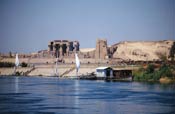 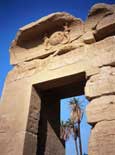 Kom
Ombo Temples (Kom
Ombo) Kom
Ombo Temples (Kom
Ombo)
The Temple of
Sobek and
Haroeris is
visible from and
overlooks the
Nile at a wide
bend in the
river. Built
during the
Ptolemaic
period, its
stands on a rock
rising out of
the sands. It is
unusual in that
it is in fact
two temples –
one devoted to
the
crocodile-god,
Sobek, and the
other to
Haroeris, the
falcon-headed
god (Horus the
Great). The
whole site is
laid out along
two parallel
axes.
The Temple of
Khnum (Esna)
The temple of
the ram-god,
Khnum, has
withstood the
ravages of time.
This may be
because it was
buried beneath
layers of silt
deposited by
successive Nile
floods. The
hypostyle hall
is an excellent
example of
Graeco-Roman
architecture.READY
TO TRAVEL
MOUNEMNTS
Most of the
Egyptian
monuments are
from the
pharaohic era,
but are also
complemented by
expressions of
other cultures.
Colossi and
Sphinxes exist
alongside
amphitheatres,
temples and
Greco-Roman
columns. A
history book
open to the
heavens …
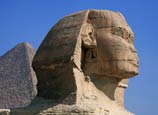 The
Great Sphinx (Giza) The
Great Sphinx (Giza)
Like the broken
arms of the
Venus de Milo,
the Great
Sphinx's long
lost nose has
made it all the
more iconic.
Standing guard
at the hallowed
entrance to the
Great Pyramids
of Giza, the
human-headed,
lion-bodied
Sphinx is the
oldest of all
Egypt's
superhuman stone
sculptures. It
is also the most
instantly
recognizable.
Originally hewn
from a gigantic
piece of
limestone
bedrock, it was
covered in
plaster and
paint in its
youth. But the
winds, waters
and sands of the
Giza Plateau
have taken their
toll. Once upon
a time, the
Great Sphinx
also wore a
Pharaoh's royal
beard. Part of
it is in the
Egyptian Museum
in Cairo and the
other part is in
the British
Museum in
London.
Though named by
the Greeks after
their
riddle-loving
mythological
character, the
Sphinx was
actually built
by the Pharaoh
Kefren in his
own image.
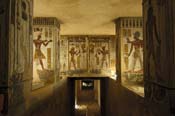 The
Valley of the
Kings (Thebes) The
Valley of the
Kings (Thebes)
Inconspicuous
and unassuming,
the Valley of
the Kings hides
its secrets
well. The grand
pyramids of the
earlier pharaohs
proved too
tempting to
grave robbers,
so from the
eighteenth to
twentieth
Dynasties, 26
pharaohs opted
to build their
tombs in the
valley. Carving
them deep into
the mountains,
far from reach,
Tutankhamun,
Ramses the Great
and Tuthmosis
III's tombs lie
in this single,
sprawling
necropolis.
There are
interesting
tombs to see in
the Valley of
the Queens and
the Valley of
the Nobles as
well.
Colossi of
Memnon (Luxor)
These are the
first ruins
visible when
arriving by
ferry. They are
the sole
surviving
remains of the
funerary temple
of Amenhotep III
which, according
to recent
discoveries, was
more vast than
the complex of
Karnak. Even
with a great
deal of
imagination, it
is difficult to
picture.
The faceless
giants stand in
front of the
first pylon with
their backs to
the mountain.
They represent
the pharaoh’s
sovereign
majesty seated
on his throne.
The funerary
complex, of
which nothing
remains, was the
biggest on the
west bank.
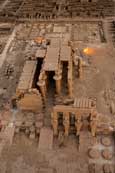
The Colossus
of Ramses the
Great (Memphis)
A colossal
statue of
Ramesses II
found on the
site is now
housed in a
museum.
The Ramesseum
(Luxor)
The funerary
temple of
Ramesses II has
lost much of its
splendour over
the centuries.
Poets sang of
its glory in
antiquity but
the dream of
self-glorification
of Ramesses II,
already
responsible for
the construction
of Abu Simbel,
has not survived
the passing of
time or
successive
pillaging. The
broken columns
and thorny trees
create a
romantic and
moving sight
particularly at
sunrise when the
first rays brush
the gigantic
statue of
Ramesses II
lying in pieces
in the ground.
Calculations
indicate that
the statue must
have measured at
least 17 m high
and weighed
around one
thousand tons.
Monuments of
the Graeco-Roman
era:
From Alexander
the Great's
grand entrance
in 332 BC to
Cleopatra's
tragic exit when
she committed
suicide in 30
BC, the Greeks
thrust Egypt
centre stage
during their
three-and-a-half
century reign
under the
Ptolomeic
Dynasty.
Not your average
colonialists,
the Ptolemaic
rulers embraced
the Egyptian
culture and
design,
continuing the
great works of
their
predecessors.
Their greatest
legacy was
Alexandria, the
glittering jewel
of the ancient
world. Its
ancient library
was a beacon of
enlightenment
and its now long
gone Caesareum,
an emblem of
sophistication.
When Cleopatra
finally chose
death, Octavian
brought Egypt
into the Roman
fold. Egypt was
relegated to
being the
Empire's bread
basket. The
Romans also
built on the
works of the
Greeks, staying
true to native
traditions until
394 AD. This is
when
Christianity
ushered in the
Coptic era and
Ancient Egypt
was finally
buried.
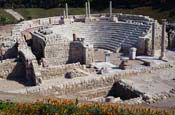 Roman
Amphitheatre in
Alexandria Roman
Amphitheatre in
Alexandria
The Roman
Amphitheatre was
found buried,
quite literally,
under a pile of
rubble ˜Kom-el-Dikkah'.
Unearthed
beneath a
Napoleonic era
fort, it's the
only known
example of a
typically
circular Roman
theatre in all
of Egypt.
Pompey's
Pillar
Majestic but
solitary,
Pompey's Pillar
is a 25 meter
column of solid
red granite,
from the bottom
of its Greek
inscribed base
to the top of
its Romanesque
capital.
Surprisingly,
Pompey's Pillar
has nothing to
do with its
namesake. It was
built in honour
of the Emperor
Diocletian in
292 AD.
The Catacombs
of Kom ash-Shuqqafa
Hewn in the
bedrock of the
mountains in the
second century,
Kom ash-Shuqqafa
is the largest
burial place in
Egypt with three
underground
storeys that
accommodate over
300 bodies. The
lowest level is
now submerged,
but a spiralling
staircase
descends to the
first two
levels, complete
with banqueting
hall (triclinium)
for funerary
feasts, and the
principal tomb
with its
eclectic clash
of Egyptian,
Greek and Roman
symbolism |
|
|
|
|